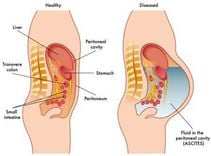This article was consulted by a Master of Medicine Specialist Doctor Level II Phan Thi Minh Huong, a gastroenterologist at Vinmec International General Hospital Da Nang.
Fatty liver disease is a dangerous condition that can threaten the health and life of patients if not detected and treated promptly. The article below will provide you with essential information about this disease.
1. What is fatty liver disease?
Fatty liver disease, also known as hepatic steatosis, is the condition of fat accumulation in the liver due to various causes. In normal people, the amount of fat in the liver is very low, about 3 - 5% of the liver's weight (including phospholipids, cholesterol, triglycerides, and fatty acids).
An increase in the amount of fat in the liver can lead to cirrhosis or liver cancer.

Based on the amount of fat in the liver, the disease is classified into the following stages of fatty liver disease:
- Grade 1 fatty liver: This is a mild form of fatty liver disease, with the amount of fat in the liver accounting for 5 - 10%. Patients can treat grade 1 fatty liver at home by eating healthy food and daily exercise.
- Grade 2 fatty liver: grade 2 fatty liver occurs when the amount of fat in the liver accounts for 10 - 25%. The symptoms of fatty liver disease at this time are not yet clear, so it is difficult for patients to detect the disease.
- Grade 3 fatty liver: grade 3 fatty liver occurs when the amount of fat in the liver is greater than 30%. This is the final and most dangerous stage of fatty liver disease.
2. Signs of grade 2 fatty liver disease
Patients with fatty liver disease often have symptoms of grade 2 fatty liver disease. If it is not detected and treated promptly, the disease will progress to grade 3 and can lead to death. Some common signs of grade 2 fatty liver include:
- Pain in the right upper quadrant: Abdominal pain accompanied by pain in the right upper quadrant is a symptom of fatty liver disease. At that time, fluids can accumulate in the abdomen, making you feel abdominal pain.

- Hyperlipidemia: hyperlipidemia is often associated with fatty liver disease. This is because the liver produces cholesterol and releases it into the bloodstream. When consuming foods high in saturated and trans fats, the liver will release more fat in the body and increase cholesterol. Therefore, blood lipids and fatty liver have a special relationship with each other.
- Jaundice (yellow skin and eyes): This is not a typical symptom. This is not only a symptom of fatty liver disease but also a symptom of many other diseases. Therefore, if this condition appears, patients should have a health check-up.
- Enlarged liver, pain on palpation: When the liver is fatty, its size increases and may be palpable.
4. Treatment of grade 2 fatty liver disease
Grade 2 fatty liver is a moderate stage of the disease, requiring timely examination and treatment because the transition boundary between grade 2 and grade 3 is unclear. If there are no appropriate treatments, it will lead to cirrhosis and, more seriously, endanger life. The treatment of grade 2 fatty liver is usually based on the cause of the disease, therefore, the role of the physician is extremely necessary:
- Fatty liver disease due to obesity: Patients need a reasonable diet that provides essential daily nutrients but minimizes the accumulation of more fat, combined with exercise to control their weight.
- Fatty liver due to malnutrition: It is necessary to build a reasonable diet, providing enough necessary nutrients for the body. However, you should not consume too much fat.
- Fatty liver due to diabetes, and viral hepatitis: These diseases need to be treated first; however, there is currently no cure for these diseases, so treatment for a stable condition is sufficient.
5. Prevent of fatty liver
To prevent fatty liver disease, you can take the following measures:
- Limit alcohol consumption and alcoholic beverages.
- Overweight and obese people must follow a reasonable diet to avoid weight gain. However, this does not mean fasting too much.
- Increased physical activity is an effective preventive measure for fatty liver disease. However, you need to choose a form of exercise that suits you.

Fatty liver disease poses a risk to the health and lives of patients if it is not detected and treated early. Therefore, regular hepatobiliary screening is the best way to prevent and detect the disease in its early stages, helping you have a timely and effective treatment plan.
If you need consultation and examination with leading Gastroenterologists at hospitals within the Vinmec Healthcare system nationwide, please schedule an appointment on the website for service.
To arrange an appointment, please call … or make your reservation directly HERE. You may also download the MyVinmec app to schedule appointments faster and manage your reservations more conveniently.













